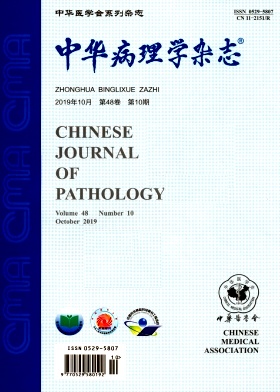[用于 HE 染色、免疫组化和分子检测的最佳黑色素去除方法]。
摘要
目的寻找苏木精和伊红(HE)染色、免疫组化和分子检测的最佳黑色素去除方法。方法: 对 38 份石蜡组织样本进行检测:收集2018年1月至2022年3月期间在中国福州福建省肿瘤医院确诊的38例恶性黑色素瘤石蜡组织样本,用于制作组织芯片。这些病例中的黑色素采用温过氧化氢、双重氧化脱色、改良高锰酸钾-草酸或三氯异氰尿酸去除,然后进行HE染色。这些病例被分为两组:一组先用上述四种方法之一去除黑色素,然后进行免疫组化(SOX-10、Ki-67、HMB45 和 Melan A);另一组先进行免疫组化染色,然后去除黑色素。随后,采集了 17 份富含黑色素的石蜡组织样本,并采用上述方法进行了脱色处理。然后提取 DNA,评估 DNA 的含量和质量。此外,还比较了不同脱色方法去除黑色素的完整性、对 HE 和免疫组化染色的影响以及 DNA 的质量。结果在去除黑色素的效果方面,改良高锰酸钾-草酸法和温热过氧化氢法最有效,两种方法都只有 5.26%(2/38)的病例出现黑色素残留。三氯异氰尿酸法有 10.53%(4/38)的黑色素残留。最差的是双重氧化脱色法,有 15.79%(6/38)的病例出现色素残留。在 HE 染色方面,温过氧化氢法的染色良好率为 92.11%,高于其他三种方法。在免疫组化染色方面,先用免疫组化法,再用改良高锰酸钾-草酸法、双重氧化法和三氯异氰尿酸法去除黑色素的平均染色评分分别为 20.84 分、26.63 分和 35.02 分。这些免疫组化染色得分高于先去除黑色素再进行免疫组化的得分(分别为 8.70、15.41 和 21.22)。温过氧化氢法去除黑色素后再进行免疫组化的平均染色评分为 33.57,高于先进行免疫组化再去除黑色素的平均染色评分(19.96)。此外,用三氯异氰尿酸法进行免疫组化染色后,HMB45、MelanA 和 Ki-67 的染色得分分别为 36.45、33.79 和 36.24,而用温过氧化氢法去除黑色素后再进行免疫组化的 SOX10 染色得分为 34.39。改良高锰酸钾-草酸法、双重氧化脱色法和三氯异氰尿酸法对 DNA 有明显降解作用,而过氧化氢法去除黑色素后提取的 DNA 平均浓度为 59.59 μg/L,大大高于未去除黑色素提取的 DNA(30.3 μg/L,P=0.001)。用双氧水去除黑色素后提取的DNA的A260/A280均在1.8至2.0之间,其中16例的A260/A230高于2.0,表明DNA的纯度很高。然而,在未去除黑色素的情况下提取的 DNA 纯度较低,其中 8 例的 A260/A280 低于 1.8,16 例的 A260/A230 低于 2.0。结论与其他三种方法相比,温过氧化氢法残留的黑色素最少,HE 染色效果更好,对 DNA 纯度/质量的影响也最小。因此,它似乎最适合用于 PCR、NGS 和其他分子检测。免疫组化染色后用三氯异氰尿酸去除黑色素的残留量最少,因此可能是最方便、最有效的方法。但需要注意的是,不同的抗体对同一种脱色方法的效果也不同。因此,应根据感兴趣的特定标记物来选择最佳的去色素方法。Objective: To seek the optimal melanin-removal method for hematoxylin and eosin (HE) staining, immunohistochemistry and molecular detection. Methods: Thirty-eight paraffin tissue samples of malignant melanoma diagnosed at the Fujian Cancer Hospital, Fuzhou, China between January 2018 and March 2022 were collected and used to make a tissue microarray. Melanin in these cases was removed using warm hydrogen peroxide, double oxidation depigmentation, modified potassium permanganate-oxalic acid or trichloroisocyanuric acid, followed by HE staining. The cases were divided into two cohorts: one was subject to the one of the above four methods to remove melanin first, followed by immunohistochemistry (SOX-10, Ki-67, HMB45 and Melan A), while the other was subject to immunohistochemical staining first and then a melanin removal. Following that, seventeen melanin-rich paraffin tissue samples were collected and depigmented using the methods described above. DNA extraction was then done, followed by assessments of DNA content and quality. Moreover, the completeness of melanin removal, the effect on HE and immunohistochemical staining, and the quality of DNA were compared between the depigmented methods. Results: Regarding the effectiveness of melanin removal, the modified potassium permanganate-oxalic acid and the warm hydrogen peroxide methods were the most effective, and both showed residual melanin in only 5.26% (2/38) of the cases. The trichloroisocyanuric acid method showed residual melanin in 10.53% (4/38) of the cases. The worst was the double oxidation depigmentation method, which showed pigment residue in 15.79% (6/38) of the cases. For HE staining, the percentage of good staining with the warm hydrogen peroxide method was 92.11%, higher than the other three methods. For immunohistochemical staining, the mean staining scores of immunohistochemistry first followed by melanin removal with modified potassium permanganate-oxalic acid, double oxidation and trichloroisocyanuric acid were 20.84, 26.63 and 35.02, respectively. These immunohistochemical staining scores were higher than those of melanin removal first followed by immunohistochemistry (8.70, 15.41 and 21.22, respectively). The mean staining score of melanin removal by warm hydrogen peroxide method followed by immunohistochemistry was 33.57, superior to that of immunohistochemistry followed by the melanin removal (19.96). Moreover, the staining scores of HMB45, MelanA and Ki-67 with immunohistochemical staining followed by trichloroisocyanuric acid method were 36.45, 33.79, and 36.24, respectively, while the staining score of SOX10 with melanin removal by warm hydrogen peroxide followed by immunohistochemistry was 34.39. The DNA was significantly degraded by modified potassium permanganate-oxalic acid, double oxidation depigmentation and trichloroisocyanuric acid, whereas the mean concentration of DNA extracted after melanin removal by hydrogen peroxide method was 59.59 μg/L, substantially higher than that of DNA extracted without melanin removal (30.3 μg/L, P=0.001). The A260/A280 of DNA extracted after melanin removal by hydrogen peroxide was between 1.8 and 2.0 in all cases, and the A260/A230 was above 2.0 in sixteen cases, suggesting high purity of DNA. However, the DNA extracted without removing the melanin showed poor purity, with A260/A280 below 1.8 in eight cases and A260/A230 below 2.0 in sixteen cases. Conclusions: Warm hydrogen peroxide showed the least melanin residue, superior HE staining and a minimal effect on DNA purity/quality compared to the other three methods. It thus appears most suitable for PCR, NGS and other molecular detection. Melanin removal with trichloroisocyanuric acid after immunohistochemical staining has the least melanin residual, and thus could be the most convenient and efficient. However, it is noted that the efficacy of the same depigmentation method varies with different antibodies. Therefore, the optimal depigmentation method should be selected based on the specific markers of interest.

 求助内容:
求助内容: 应助结果提醒方式:
应助结果提醒方式:


